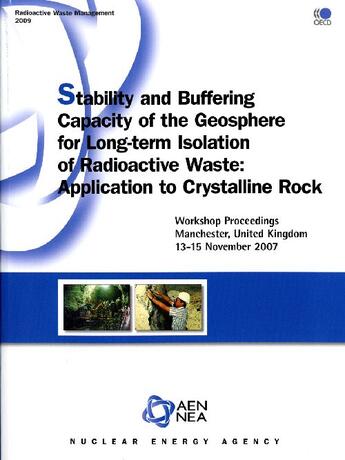Résumé:
Geological settings selected as potential host formations for the deep geological disposal of radioactive waste are chosen for, among other assets, their long-term stability and buffering capacity against destabilising events and processes. These proceedings present the outcomes of a geosphere... Voir plus
Geological settings selected as potential host formations for the deep geological disposal of radioactive waste are chosen for, among other assets, their long-term stability and buffering capacity against destabilising events and processes. These proceedings present the outcomes of a geosphere stability workshop, held in November 2007, that focused on crystalline and other types of hard, fractured rocks. The workshop underscored the fact that many such rocks are intrinsically stable environments that evolve extremely slowly and provide good buffering against external events and processes.
The proceedings show a good understanding of the processes and events that can affect crystalline rocks and, although there is less confidence in predicting exactly when and where such events will occur and the volume of rock that will be affected, the extent of the impacts on a geological repository can be confidently addressed using bounding approaches supported by geological information from similar sites around the world.
Tables des matières:
Executive Summary Introduction Scope and Objectives of the Workshop Synthesis of the Workshop Poster Session Conclusions SESSION I. GENERAL FRAMEWORK: CRYSTALLINE ROCKS AS HOST FORMATIONS -Safety Functions of Crystalline Rock Formations in Deep Geological Disposal and Their Handling in a Safety Case - SKB's SR-CAN Example by A. Hedin, J. Andersson, R. Munier, J-O Naslund, I. Puigdomenech, and J-O. Selroos -Regulatory Expectations Concerning the Confidence in Geosphere Stability and its Handling in an Environmental Safety Case by S. L. Duerden SESSION II. EXAMPLES OF KEY PROCESSES AFFECTING THE GEOSPHERE FOR CRYSTALLINE ROCK -Likelihood of Tectonic Activity Affecting the Geological Stability of a Repository in Japan: Development of NUMO's ITM Methodology by N.A. Chapman, J. Goto, and H. Tsuchi -Climate Change and its Potential Impact on Mechanical, Hydraulic and Chemical Conditions by J-O. Naslund -Uplift and Erosion: Potential Impact on the Geological Environment by H. Yamakazi and T. Sasaki -Predictability of the Evolution of Hydrogeological and Hydrogeochemical Systems; Geological Disposal of Nuclear Waste in Crystalline Rocks by W. M. Murphy and D. M. Diodato -Geological and Rock Mechanics Aspects of the Long-term Evolution of a Crystalline Rock Site by J.W. Cosgrove and J. A. Hudson SESSION III. ARGUMENTS TO SUPPORT CONFIDENCE IN THE STABILITY OF CRYSTALLINE ROCKS AS POTENTAIL HOST FORMATIONS -Lithological History and Ductile Deformation: The Lessons for Long-term Stability of Large-scales Structures in the Olkiluoto by L. Wikstrom, I. Aaltonen, and J. Mattila -Stability and Predictability in Younger Crystalline Rock System: Japanese Islands Case by S. Yoshida -Developing Confidence in Stability and Predictability of a Repository in Unsaturated Tuffs by E. Smistad and R. Linden SESSION IV. RESPONSE AND RESILIENCE OF CRYSTALLINE ROCK TO NATURAL PERTURBATIONS AND GEOSPHERE EVOLUTION (BUFFERING) -Fracture Reactivation in Response to Seismic Events by H. Hokmark, B. Falth and R. Munier -Buffering against Intrusion of Groundwater of Undesirable Composition by P. Pitkanen, A. Luukkonen and S. Partamies -Understanding shield Groundwater Flow Domain Evolution during the Quaternary Period to Build Confidence in Repository Long-term Safety by M. Ben Belfadhel and M. Jensen -Hydraulic and Hydrochemical Response to Seismic Events by T. Nohara POSTER SESSION -Discipline-integrated Modelling Approach for Describing the Olkiluoto Crystalline Site in Finland by J. Andersson, J. Mattila, J.A. Hudson, L. Koskinen, P. Pitkanen, M. Ylla-Mella, P. Hella -Study on Characterisation of Quaternary Tectonic Movement by Uplift Estimation using Fluvial Terraces by R. Hataya, M. Yanagida and M. Sato -Examination of Earthquake Ground Motion in the Deep Underground Environment of Japan by J. Goto, H. Tsuchi, and M. Mashimo -Frequency of Fault Occurrence at Shallow Depths during Plio-pleistocene and Estimation of the Incident of New Faults by H. Shiratsuchi and S. Yoshida -The Role of the Geoshpere in Posiva's Safety Case by N. Marcos, P. Hella, Ml Snellman, M. Nykyri, B. Pastina, M. Vahanen and K. Koskinen -Understanding the Characteristics of Long-term Spatio-temporal Variation in Volcanism and the Continuity of the Related Phenomena for Estimating Regions of New Volcano Development by H. Kondo -Numerical Assessment of the Influence of Topographic and Climatic Perturbations on Groundwater Flow Conditions by H. Saegusa, K-I Yasue, H. Oneo, T. Moriya, and K. Nakano -Impacts of Natural Events and Processes on Groundwater Flow Conditions: A Case Study in the Horonobe Area, Hokkaido, Northern Japan by T. Niizato, K-I Yasue and H. Kurikami -Groundwater Flow Prediction Method in Consideration of Long-term Topographic Changes of Uplift and Erosion by T. Sasaki, T. Moritomo, Y. Ikeda, T. Shiraishi, and S. Sugi -An Integrated Approach for Detecting Latent Magmatic Activity beneath Non-volcanic Regions: An Example form the Crystalline Iide Mountains, Northeast Japan by K. Umeda














